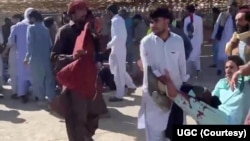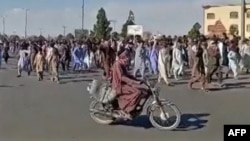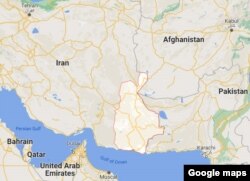They were unarmed and praying in a mosque when security forces fired indiscriminately from a nearby security post. One woman, while praying in full Islamic hijab, was killed by a tear gas grenade as several men hit by bullets were lying dead and wounded inside the same mosque on September 30.
It is now called “the bloody Friday” on which, according to human rights groups, about 66 civilians were massacred and more than 100 were injured inside and outside the mosque in Iran’s Sistan-Baluchistan province.
The victims were Sunnis, a religious minority making up 12% to 20% of Iran’s 86 million people, and the shooters were the armed forces of a Shia theocratic regime that has long been accused of brutally repressing religious minorities.
While Iran's seismic protests are widely reported to be in reaction to the suspicious death of a young woman, Mahsa Amini, in police detention in Tehran, some of the regime’s most brutal crackdowns have taken place in the Sunni-populated regions.
Even Amini, the woman who has posthumously become the symbol of Iranians’ protests, was from a Sunni tribe and visiting Tehran when she was detained and allegedly tortured for not wearing a hijab properly.
“Nearly 100 ordinary people were martyred, most of them inside the mosque, with bullets in their hearts and heads,” Abdolhamid Ismaeelzahi, a prominent Sunni cleric and leader of the mosque where the September 30 shooting took place, told an envoy of Iran’s supreme leader on Sunday, according to a statement on Isameelzahi’s website.
Bloody Friday in Zahedan, provincial capital of Sistan-Baluchistan province, “was the result of discriminations against the Sunni community,” the cleric said, adding that the region’s majority Sunnis have no representation in the provincial government or security forces.
Brutal crackdowns
Since the mid-September start of Iran's nationwide protests, at least 340 people, including more than 40 teenagers, have been killed and over 15,000 jailed, according to human rights observers.
As if unsatisfied with the violence perpetrated by state security forces, some Iranian lawmakers have called for the summary execution of all detainees.
“The degree of brutality that the regime has deployed in Sistan-Baluchistan is at a different scale,” Ali Vaez, an Iranian affairs expert at the International Crisis Group, told VOA.
By hitting religious minorities hard in Sistan-Baluchistan, said Vaez, Shia autocrats deter the broader public from joining the protests.
The U.N., human rights organization and several countries have called on Iranian authorities to end the crackdowns, release the prisoners and respect the right to peaceful protests.
“We urge Iranian authorities to stop using the death penalty as a tool to squash protests and reiterate our call to immediately release all protesters who have been arbitrarily deprived of their liberty for the sole reason of exercising their legitimate rights to freedom of opinion and expression," a U.N.-affiliated group of human rights experts said in a statement last week. The group also called on Tehran to allow for peaceful assembly and the promotion of human rights.
“The initial response was a bloodbath,” Barbara Slavin, a specialist on Iran affairs at the Atlantic Council, told VOA. “Authorities have since tried to mitigate the damage, admitting police responsibility for the high death toll on September 30, but tensions remain extremely high.”
Iranian authorities have called the protesters insurrectionists, accusing them of trying to destabilize the country at the behest of the U.S. and Israel.
The U.S. government has publicly voiced support for the protesters but has not confirmed providing logistical, intelligence or financial assistance.
“It's no surprise that the Islamic Republic is blaming its own failures on others," said Vaez. "Neither the U.S. nor Iran's regional rivals arrested and killed Mahsa Amini, triggering an avalanche that was in the making for many years because of the regime's own corruption, mismanagement and authoritarianism.”
Long-standing grievances
For decades, Iranian women — along with the country's religious and ethnic minorities — have demanded greater rights, equality and political representation in government, but the regime has mostly responded with executions, prolonged detentions and other forms of state-sponsored violence, according to human rights groups.
Between 2014 and 2020, Iranian forces killed more than 1,000 Kurdish couriers near the border with Azerbaijan, the U.S. State Department said in its 2020 human rights report on Iran. Iran has about 10 million Kurds who are mostly Sunni but also have small Shia, Yazidi and Bahai followers.
Like the Kurds, the Baluch ethnic minority has long been discriminated against in Iran. Predominately Sunnis, Iran's 2 million-strong Baluch live mostly in Sistan-Baluchistan province bordering Afghanistan and Pakistan.
“A great part of the society is fed up with the Islamic Republic,” said Vaez. “But of course, these grievances run much deeper in border provinces, where the country's minorities reside.”
While Iranian leaders boast the “insurrections” have been effectively staved off, protests persist amid growing internal grievances against the regime.
“I am worried in the short term about even more repression but optimistic in the long term that change has come and will continue,” said Slavin of the Atlantic Council.










